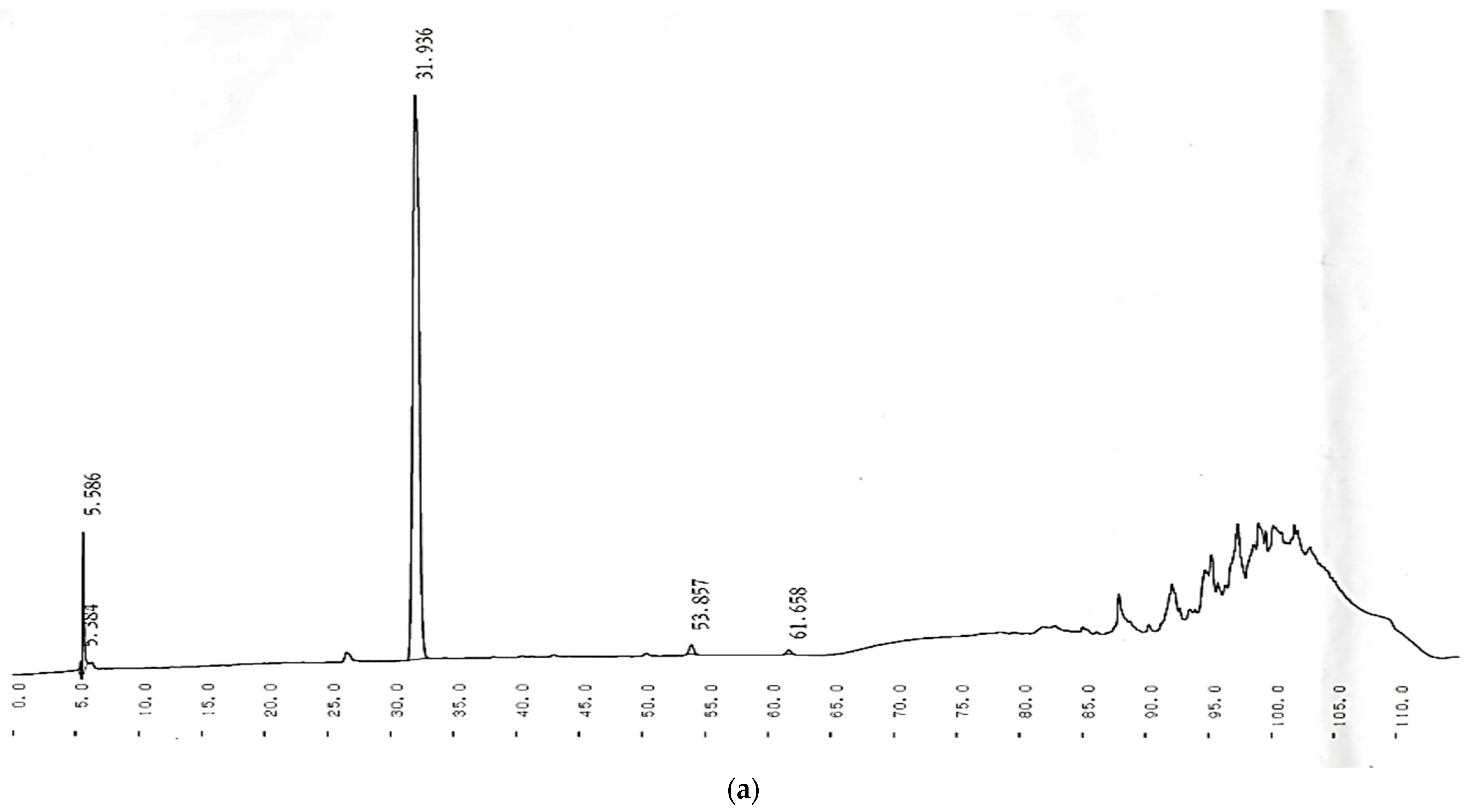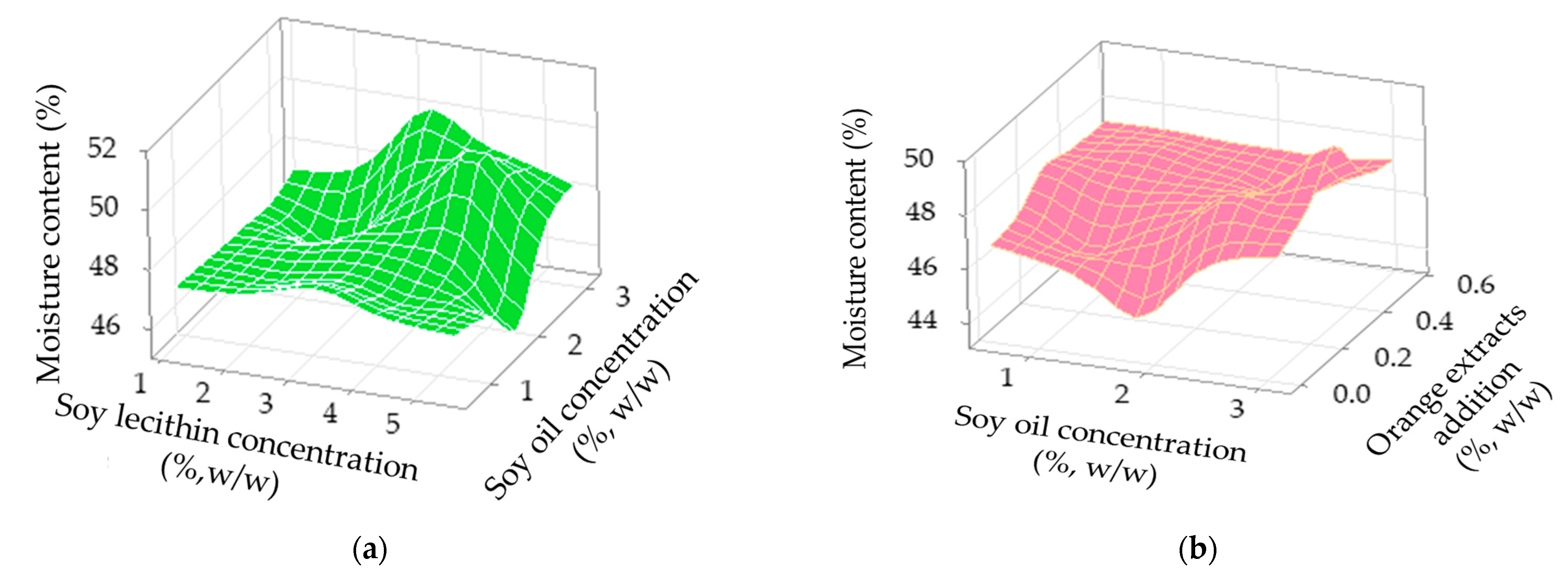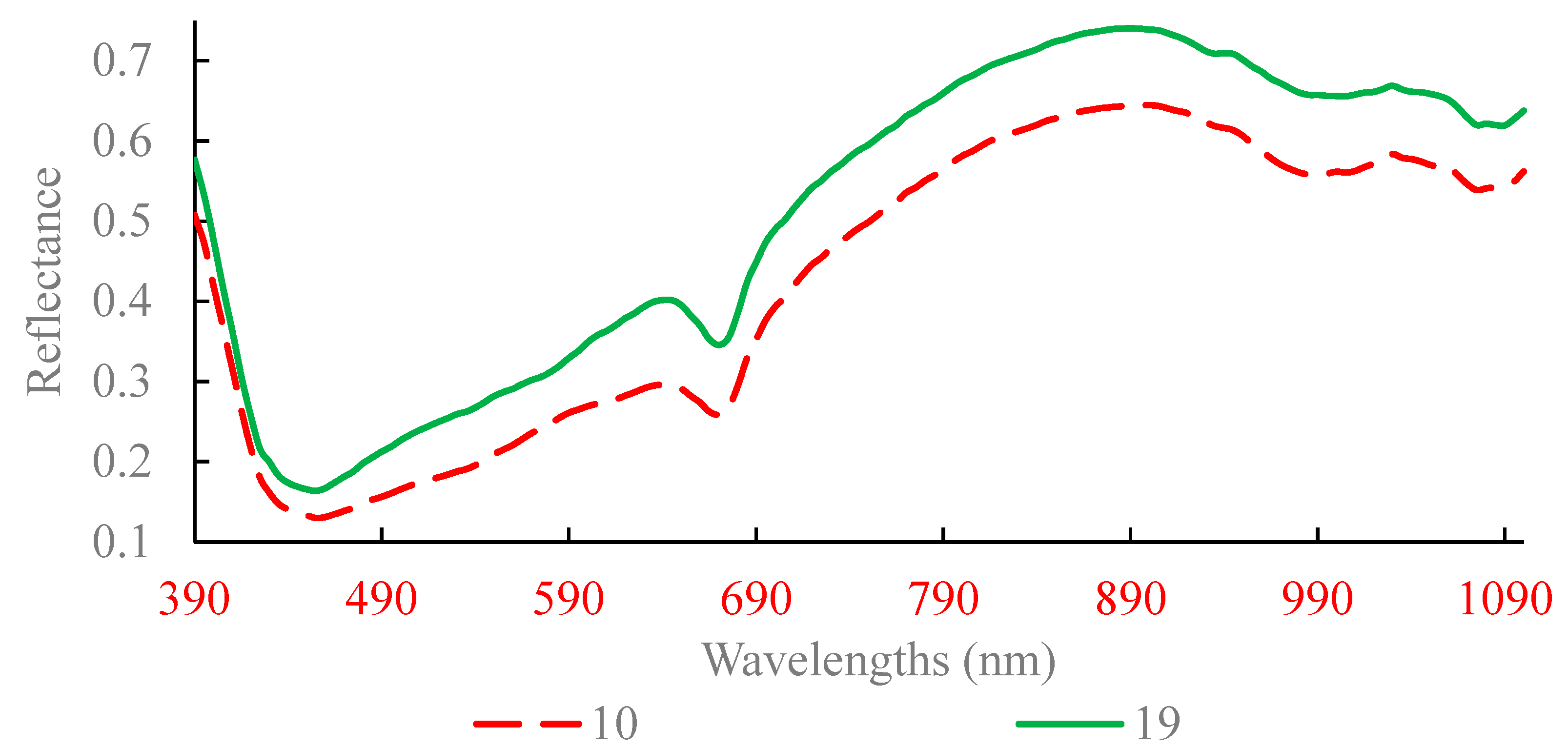Estimating Moisture Content of Sausages with Different Types of Casings via Hyperspectral Imaging in Tandem with Multivariate
Abstract
1. Introduction
2. Materials and Methods
2.1. Orange Crude Extraction and Sausage Preparation
2.2. Reference Analysis
2.3. Identification of the Chemical Profile of Orange Extracts by High-Performance Liquid Chromatography (HPLC)
2.4. Hyperspectral Data Processing
2.5. Model Establishment
2.6. Selection of Important Wavelengths and Model Evaluation
3. Results and Discussion
3.1. HPLC Profile of Orange Extracts from Waste Orange Peels
3.2. Effects on the Moisture Content of Sausage Core
3.3. Spectra Overview
3.4. Calibration Model Using the Entire Range of Wavelengths
3.5. Calibration Model Using Important Wavelengths
4. Conclusions
- (1)
- The results showed that sausage cores with treatment 19 (SLC: 2.11%, SOC: 1.18%, Treated time: 60 min, OPE: 0.12%, lactic acid addition to salt: 21 mL/kg NaCl) modified casing had lower moisture content than those with treatment 10 modified casing (SLC: 3.16%, SOC: 1.78%, treated time: 45 min, OPE: 0.26%, lactic acid addition to salt: 19.5 mL/kg NaCl).
- (2)
- Response surface methodology was used to investigate the effect of different modification processes with varying concentrations of orange extracts on moisture content, achieving an R2 of 78.28% and an insignificant lack of fit. Moisture content increased to 48–50% when a high soy lecithin concentration (>3.9%) was associated with a higher soy oil concentration (2.0%) or a higher concentration of soy oil (>2.3%) combined with an addition of orange extracts between 0.05% and 0.40%.
- (3)
- Nine important wavelengths (405, 445, 425, 455, 585, 630, 1000, 1075, and 1095 nm) were identified that could be used for the development of a simple and cost-effective multispectral system or for online industrial employment.
Author Contributions
Funding
Institutional Review Board Statement
Informed Consent Statement
Data Availability Statement
Acknowledgments
Conflicts of Interest
References
- Siripatrawan, U.; Makino, Y. Simultaneous assessment of various quality attributes and shelf life of packaged bratwurst using hyperspectral imaging. Meat Sci. 2018, 146, 26–33. [Google Scholar] [CrossRef] [PubMed]
- Feng, C.H.; Makino, Y.; Yoshimura, M.; Thuyet, D.C.; García-Martín, J.F. Hyperspectral imaging in tandem with R statistics and image processing for detection and visualisation of pH in Japanese big sausages under different storage conditions. J. Food Sci. 2018, 83, 358–366. [Google Scholar] [CrossRef] [PubMed]
- Feng, C.H.; Makino, Y.; Yoshimura, M.; Rodríguez-Pulido, F.J. Real-time prediction of pre-cooked Japanese sausages color with different storage days using hyperspectral imaging. J. Sci. Food Agric. 2018, 98, 2564–2572. [Google Scholar] [CrossRef] [PubMed]
- Rodríguez-Pulido, F.J.; Hernández-Hierro, J.M.; Nogales-Bueno, J.; Gordillo, B.; González-Miret, M.L.; Heredia, F.J. A novel method for evaluating flavanols in grape seeds by near infrared hyperspectral imaging. Talanta 2014, 122, 145–150. [Google Scholar] [CrossRef]
- Rodríguez-Pulido, F.J.; Gordillo, B.; Heredia, F.J.; González-Miret, M.L. CIELAB—Spectral image matching: An app for merging colorimetric and spectral images for grapes and derivatives. Food Control 2021, 125, 108038. [Google Scholar] [CrossRef]
- Rodríguez-Pulido, F.J.; Mora-Garrido, A.B.; González-Miret, M.L.; Heredia, F.J. Research progress in imaging technology for assessing quality in wine grapes and seeds. Foods 2022, 11, 254. [Google Scholar] [CrossRef] [PubMed]
- Cheng, J.H.; Sun, J.; Yao, K.S.; Xu, M.; Tian, Y.; Dai, C.X. A decision fusion method based on hyperspectral imaging and electronic nose techniques for moisture content prediction in frozen-thawed pork. LWT Food Sci. Technol. 2022, 165, 113778. [Google Scholar] [CrossRef]
- Zhuang, Q.B.; Peng, Y.K.; Yang, D.Y.; Wang, Y.L.; Zhao, R.H.; Chao, K.L.; Guo, Q.H. Detection of frozen pork freshness by fluorescence hyperspectral image. J. Food Eng. 2022, 316, 110840. [Google Scholar] [CrossRef]
- Cheng, J.H.; Sun, J.; Yao, K.S.; Xu, M.; Zhou, X. Nondestructive detection and visualization of protein oxidation degree of frozen-thawed pork using fluorescence hyperspectral imaging. Meat Sci. 2022, 194, 108975. [Google Scholar] [CrossRef]
- Hu, M.-H.; Dong, Q.-L.; Liu, B.-L. Classification and characterization of blueberry mechanical damage with time evolution using reflectance, transmittance and interactance imaging spectroscopy. Comput. Electron. Agric. 2016, 122, 19–28. [Google Scholar] [CrossRef]
- Hu, M.-H.; Dong, Q.-L.; Liu, B.-L.; Opara, U.L. Prediction of mechanical properties of blueberry using hyperspectral interactance imaging. Postharvest Biol. Technol. 2016, 115, 122–131. [Google Scholar] [CrossRef]
- Wan, G.-L.; Fan, S.-X.; Liu, G.S.; He, J.G.; Wang, W.; Li, Y.; Cheng, L.J.; Ma, C.; Guo, M. Fusion of spectra and texture data of hyperspectral imaging for prediction of myoglobin content in nitrite-cured mutton. Food Control 2023, 144, 109332. [Google Scholar] [CrossRef]
- Zhang, J.J.; Ma, Y.H.; Liu, G.S.; Fan, N.Y.; Li, Y.; Sun, Y.R. Rapid evaluation of texture parameters of Tan mutton using hyperspectral imaging with optimization algorithms. Food Control 2022, 135, 108815. [Google Scholar] [CrossRef]
- Zhang, J.J.; Liu, G.S.; Li, Y.; Guo, M.; Pu, F.N.; Wang, H. Rapid identification of lamb freshness grades using visible and near-infrared spectroscopy (Vis-NIR). J. Food Compos. Anal. 2022, 111, 104590. [Google Scholar] [CrossRef]
- Ktenioudaki, A.; Esquerre, C.A.; Nunes, C.M.D.N.; O’Donnell, C.P. A decision support tool for shelf-life determination of strawberries using hyperspectral imaging technology. Biosyst. Eng. 2022, 221, 105–117. [Google Scholar] [CrossRef]
- León-Ecay, S.; López-Maestresalas, A.; Murillo-Arbizu, M.T.; Beriain, M.J.; Mendizabal, J.A.; Arazuri, S.; Carmen, J.; Bass, P.D.; Colle, M.J.; García, D.; et al. Classification of beef longissimus thoracis muscle tenderness using hyperspectral imaging and chemometrics. Foods 2022, 11, 3105. [Google Scholar] [CrossRef]
- Song, K.; Wang, S.-H.; Yang, D.; Shi, T.-Y. Combination of spectral and image information from hyperspectral imaging for the prediction and visualization of the total volatile basic nitrogen content in cooked beef. J. Food Meas. Charact. 2021, 15, 4006–4020. [Google Scholar] [CrossRef]
- Xie, A.G.; Sun, J.; Wang, T.M.; Liu, Y.H. Visualized detection of quality change of cooked beef with condiments by hyperspectral imaging technique. Food Sci. Biotechnol. 2022, 31, 1257–1266. [Google Scholar] [CrossRef]
- Ahmed, M.; Reed, D.D.; Young, J.M.; Eshkabilov, S.; Berg, E.P.; Sun, X. Beef quality grade classification based on intramuscular fat content using hyperspectral imaging technology. Appl. Sci. 2021, 11, 4588. [Google Scholar] [CrossRef]
- Cernadas, E.; Fernández-Delgado, M.; Fulladosa, E.; Munoz, I. Automatic marbling prediction of sliced dry-cured ham using image segmentation, texture analysis and regression. Expert Syst. Appl. 2022, 206, 117765. [Google Scholar] [CrossRef]
- Feng, C.H.; Makino, Y.; García-Martín, J.F. Hyperspectral imaging coupled with multivariate analysis and image processing for detection and visualisation of colour in cooked sausages stuffed with different modified casings. Foods 2020, 9, 1089. [Google Scholar] [CrossRef] [PubMed]
- Feng, C.H.; Makino, Y.; Yoshimura, M.; Rodríguez-Pulido, F.J. Estimation of adenosine triphosphate content in ready-to-eat sausages with different storage days, using hyperspectral imaging coupled with R statistics. Food Chem. 2018, 264, 419–426. [Google Scholar] [CrossRef] [PubMed]
- Siripatrawan, U. Hyperspectral imaging for rapid evaluation and visualization of quality deterioration index of vacuum packaged dry-cured sausages. Sens. Actuators B Chem. 2018, 254, 1025–1032. [Google Scholar] [CrossRef]
- Ma, F.; Zhang, B.; Wang, W.; Li, P.J.; Niu, X.L.; Chen, C.; Zheng, L. Potential use of multispectral imaging technology to identify moisture content and water-holding capacity in cooked pork sausages. J. Sci. Food Agric. 2018, 98, 1832–1838. [Google Scholar] [CrossRef]
- Feng, C.H.; Arai, H.; Rodríguez-Pulido, F.J. Evaluation of pH in sausages stuffed in a modified casing with orange extracts by hyperspectral imaging coupled with response surface methodology. Foods 2022, 11, 2797. [Google Scholar] [CrossRef]
- Feng, C.H.; Drummond, L.; Zhang, Z.H. Evaluation of innovative immersion vacuum cooling with different pressure reduction rates and agitation for cooked sausages stuffed in natural or artificial casing. LWT Food Sci. Technol. 2014, 59, 77–85. [Google Scholar] [CrossRef]
- Feng, C.H.; Drummond, L.; Sun, D.W.; Zhang, Z.-H. Evaluation of natural hog casings modified by surfactant solutions combined with lactic acid by response surface methodology. LWT Food Sci. Technol. 2014, 58, 427–438. [Google Scholar] [CrossRef]
- Manzoor, A.; Haque, A.; Ahmad, S.; Hopkins, D.L. Incorporation of betel leaf extract provides oxidative stability and improves phytochemical, textural, sensory and antimicrobial activities of buffalo meat sausages. Meat Sci. 2023, 200, 109157. [Google Scholar] [CrossRef]
- Zhang, Y.L.; Lu, Y.Y.; Chen, F.S. Relationship between physicochemical properties and microbial structural distribution of Chinese-style and Salami fermented sausages. Food Biosci. 2023, 53, 102583. [Google Scholar] [CrossRef]
- Feng, C.H. Quality evaluation and mathematical modelling approach to estimate the growth parameters of total viable count in sausages with different casings. Foods 2022, 11, 634. [Google Scholar] [CrossRef]
- Feng, C.-H.; Otani, C.; Ogawa, Y. Innovatively identifying naringin and hesperidin by using terahertz spectroscopy and evaluating flavonoids extracts from waste orange peels by coupling with multivariate analysis. Food Control 2022, 137, 108897. [Google Scholar] [CrossRef]
- Sammani, M.S.; Cerdὰ, V. Sample pre-treatment and flavonoids analytical methodologies for the quality control of foods and pharmaceutical matrices. In The Book of Flavonoids, 1st ed.; Feng, C.-H., García Martín, J.F., Eds.; Nova Science Publishers, Inc.: New York, NY, USA, 2021; Chapter 1; pp. 1–130. [Google Scholar]
- Bellavite, P.; Donzelli, A. Hesperidin and SARS-CoV-2: New light on the healthy function of citrus fruits. Antioxidants 2020, 9, 742. [Google Scholar] [CrossRef] [PubMed]
- Sawalha, S.M.S.; Arráez-Román, D.; Segura-Carretero, A.; Fernández-Gutiérrez, A. Quantification of main phenolic compounds in sweet and bitter orange peel using CE-MS/MS. Food Chem. 2009, 116, 567–574. [Google Scholar] [CrossRef]
- Li, X.W.; Geng, M.M.; Peng, Y.Z.; Meng, L.S.; Lu, S.M. Molecular immune pathogenesis and diagnosis of COVID-19. J. Pharm. Anal. 2020, 10, 102–108. [Google Scholar] [CrossRef]
- Feng, C.H.; Arai, H. Evaluation of hesperidin on sausages stuffed in a new modified casing during long-term storage—A preliminary study. Sustainability 2022, 14, 9071. [Google Scholar] [CrossRef]
- Mishra, A.; Mohite, A.M.; Sharma, N. Influence of particle size on physical, mechanical, thermal, and morphological properties of tamarind- fenugreek mucilage biodegradable films. Polym. Bull. 2023, 80, 3119–3133. [Google Scholar] [CrossRef]
- Feng, C.H.; García-Martín, J.F.; Lavado, M.B.; López-Barrera, M.C.; Álvarez-Mateos, P. Evaluation of different solvents on flavonoids extraction efficiency from sweet oranges and ripe and immature Seville oranges. Int. J. Food Sci. 2020, 55, 3123–3134. [Google Scholar] [CrossRef]
- Nogata, Y.; Sakamoto, K.; Shiratsuchi, H.; Ishii, T.; Yano, M.; Ohta, H. Flavonoid composition of fruit tissues of citrus species. Biosci. Biotechnol. Biochem. 2006, 70, 178–192. [Google Scholar] [CrossRef]
- Jung, E.-Y.; Yun, I.-R.; Go, G.-W.; Kim, G.-D.; Seo, H.-W.; Joo, S.-T.; Yang, H.-S. Effects of radix puerariae extracts on physicochemical and sensory quality of precooked pork sausage during cold storage. LWT Food Sci. Technol. 2012, 46, 556–562. [Google Scholar] [CrossRef]
- Zhang, J.; Zhang, L.Y.; Lai, C.L.; Liang, Y.; Gao, L.L.; Kaliaperumal, K.; Jiang, Y.M. Nutraceutical potential of navel orange peel in diabetes management: The chemical profile, antioxidant, α-glucosidase inhibitory and antiglycation effects of its flavonoids. Food Biosci. 2022, 49, 101943. [Google Scholar] [CrossRef]
- Feng, C.H. Optimizing procedures of ultrasound-assisted extraction of waste orange peels by response surface methodology. Molecules 2022, 27, 2268. [Google Scholar] [CrossRef] [PubMed]
- Sanz, J.A.; Fernandes, A.M.; Barrenechea, E.; Silva, S.; Santos, V.; Gonçalves, N.; Paternain, D.; Jurio, A.; Melo-Pinto, P. Lamb muscle discrimination using hyperspectral imaging: Comparison of various machine learning algorithms. J. Food Eng. 2016, 174, 92–100. [Google Scholar] [CrossRef]
- Jamil, Z.; Mohite, A.; Sharma, N. Selected engineering properties and drying behavior of tendu (diospyros melanoxylon roxb.) fruit. Curr. Res. Nutr. Food Sci. 2020, 8, 622–629. [Google Scholar] [CrossRef]
- Jia, B.B.; Yoon, S.-C.; Zhuang, H.; Wang, W.; Li, C.Y. Prediction of pH of fresh chicken breast fillets by VNIR hyperspectral imaging. J. Food Eng. 2017, 08, 57–65. [Google Scholar] [CrossRef]
- Helland, I.S.; Næs, T.; Isaksson, T. Related versions of the multiplicative scatter correction method for preprocessing spectroscopic data. Chemom. Intell. Lab. Syst. 1995, 29, 233–241. [Google Scholar] [CrossRef]





| Factor | Coded (Xi) Variable Level | ||||
|---|---|---|---|---|---|
| Star | Low | Center | High | Star | |
| −2 | −1 | 0 | 1 | 2 | |
| 1 SLC (%, w/w) | 1.08 | 2.15 | 3.17 | 4.20 | 5.17 |
| 2 SOC (%, w/w) | 0.60 | 1.18 | 1.78 | 2.39 | 2.94 |
| 3 Treated Time (min) | 45 | 60 | 75 | 90 | 105 |
| 4 Orange Extracts (%, w/w) | 0 | 0.12 | 0.26 | 0.40 | 0.54 |
| 5 Lactic Acid (ml/kg NaCl) | 16.5 | 18 | 19.5 | 21 | 22.5 |
| Coded Coefficients | ||||
|---|---|---|---|---|
| Term | Coefficients | SE Coefficients | t-Value | p-Value |
| Constant | 48.004 | 0.689 | 69.72 | 0 |
| 1 SLC | 0.568 | 0.352 | 1.61 | 0.136 |
| 2 SOC | 0.467 | 0.352 | 1.33 | 0.212 |
| 3 Treated Time | −0.424 | 0.352 | −1.2 | 0.254 |
| 4 Orange Extracts | 0.228 | 0.352 | 0.65 | 0.532 |
| 5 Lactic Acid | −0.478 | 0.352 | −1.36 | 0.202 |
| Square | ||||
| 1 SLC2 | −0.423 | 0.319 | −1.33 | 0.211 |
| 2 SOC2 | 0.296 | 0.319 | 0.93 | 0.372 |
| 3 Treated Time2 | 0.258 | 0.319 | 0.81 | 0.435 |
| 4 Orange Extracts2 | −0.418 | 0.319 | −1.31 | 0.216 |
| 5 Lactic Acid2 | −0.438 | 0.319 | −1.37 | 0.197 |
| 2-way interaction | ||||
| 1 SLC × 2 SOC | 1.147 | 0.432 | 2.66 | 0.022 |
| 1 SLC × 3 Treated Time | −0.701 | 0.432 | −1.62 | 0.133 |
| 1 SLC × 4 Orange Extracts | −0.253 | 0.432 | −0.59 | 0.570 |
| 1 SLC × 5 Lactic Acid | 0.091 | 0.432 | 0.21 | 0.838 |
| 2 SOC × 3 Treated Time | −0.597 | 0.432 | −1.38 | 0.194 |
| 2 SOC × 4 Orange Extracts | −0.999 | 0.432 | −2.31 | 0.041 |
| 2 SOC × 5 Lactic Acid | 0.832 | 0.432 | 1.93 | 0.080 |
| 3 Treated Time × 4 Orange Extracts | −0.308 | 0.432 | −0.71 | 0.490 |
| 3 Treated Time × 5 Lactic Acid | 0.344 | 0.432 | 0.8 | 0.443 |
| 4 Orange Extracts × 5 Lactic Acid | −0.64 | 0.432 | −1.48 | 0.166 |
| Treatments | Training Set (n = 22) | Prediction Set (n = 11) | Cross-Validation | ||||
|---|---|---|---|---|---|---|---|
| Rc2 | RMSEC (%) | Rp2 | RMSEP (%) | Rcv2 | RMSECV (%) | ||
| Full wavelengths | Untreated (Raw) | 0.2602 | 1.6653 | 0.0338 | 2.8540 | 0.0414 | 2.2560 |
| Normalization | 0.3331 | 1.5812 | 0.0325 | 2.8559 | 0.0454 | 2.2513 | |
| 1st Derivation | 0.5845 | 1.2480 | 0.0498 | 2.8302 | 0.0473 | 2.2491 | |
| 2nd Derivation | 0.3165 | 1.6007 | Na | 3.1939 | 0.4003 | 1.7844 | |
| Standard normal variate | 0.0303 | 1.9067 | Na | 3.0137 | 0.0146 | 2.2873 | |
| Multiplicative scatter correction | 0.0300 | 1.9070 | Na | 3.0121 | 0.0143 | 2.2877 | |
| Normalization and 1st Derivation | 0.7157 | 1.0324 | 0.0566 | 2.8200 | 0.0416 | 2.2558 | |
| 1st Derivation and Normalization | 0.0467 | 1.8905 | Na | 2.9187 | 0.0704 | 2.2216 | |
| Normalization and 2nd Derivation | 0.3108 | 1.6074 | Na | 3.2091 | 0.3752 | 1.8213 | |
| 2nd Derivation and Normalization | 0.6033 | 1.2195 | 0.1348 | 2.7006 | 0.1464 | 2.1289 | |
| Important wavelengths | Untreated (Raw) | 0.3143 | 1.6034 | 0.0444 | 2.8383 | 0.0304 | 2.2688 |
| Normalization | 0.3149 | 1.6026 | 0.0579 | 2.8181 | 0.0791 | 2.2112 | |
| 1st Derivation | 0.3761 | 1.5294 | 0.0241 | 2.8683 | 0.1696 | 2.0998 | |
| 2nd Derivation | 0.3037 | 1.6157 | 0.0454 | 2.8368 | 0.1495 | 2.1250 | |
| Standard normal variate | 0.3218 | 1.5946 | 0.0446 | 2.8380 | 0.2197 | 2.0353 | |
| Multiplicative scatter correction | 0.3162 | 1.6011 | 0.0519 | 2.8271 | 0.05401 | 2.2411 | |
| Normalization and 1st Derivation | 0.3436 | 1.5687 | 0.0301 | 2.8594 | 0.2060 | 2.0531 | |
| 1st Derivation and Normalization | 0.0647 | 1.8726 | Na | 3.0806 | 0.0872 | 2.2015 | |
| Normalization and 2nd Derivation | 0.1846 | 1.7484 | Na | 2.9907 | 0.1375 | 2.1399 | |
| 2nd Derivation and Normalization | 0.1751 | 1.7586 | 0.1150 | 2.7313 | 0.0104 | 2.2922 | |
Disclaimer/Publisher’s Note: The statements, opinions and data contained in all publications are solely those of the individual author(s) and contributor(s) and not of MDPI and/or the editor(s). MDPI and/or the editor(s) disclaim responsibility for any injury to people or property resulting from any ideas, methods, instructions or products referred to in the content. |
© 2023 by the authors. Licensee MDPI, Basel, Switzerland. This article is an open access article distributed under the terms and conditions of the Creative Commons Attribution (CC BY) license (https://creativecommons.org/licenses/by/4.0/).
Share and Cite
Feng, C.-H.; Arai, H. Estimating Moisture Content of Sausages with Different Types of Casings via Hyperspectral Imaging in Tandem with Multivariate. Appl. Sci. 2023, 13, 5300. https://doi.org/10.3390/app13095300
Feng C-H, Arai H. Estimating Moisture Content of Sausages with Different Types of Casings via Hyperspectral Imaging in Tandem with Multivariate. Applied Sciences. 2023; 13(9):5300. https://doi.org/10.3390/app13095300
Chicago/Turabian StyleFeng, Chao-Hui, and Hirofumi Arai. 2023. "Estimating Moisture Content of Sausages with Different Types of Casings via Hyperspectral Imaging in Tandem with Multivariate" Applied Sciences 13, no. 9: 5300. https://doi.org/10.3390/app13095300
APA StyleFeng, C.-H., & Arai, H. (2023). Estimating Moisture Content of Sausages with Different Types of Casings via Hyperspectral Imaging in Tandem with Multivariate. Applied Sciences, 13(9), 5300. https://doi.org/10.3390/app13095300








